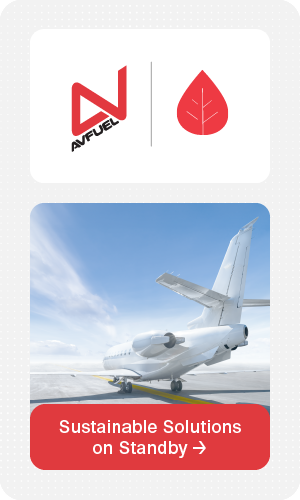The threat posed by greenhouse gases (GHG) as a major contributor to climate change has prompted the aviation industry to move toward a zero-emissions goal by 2050. In that regard, last November U.S. Secretary of Transportation Pete Buttigieg announced the U.S. Aviation Climate Action Plan at the United Nations Climate Change Conference in Glasgow, Scotland. The plan, which for the first time describes how the U.S will reach the 2050 objective, cites production of sustainable aviation fuels (SAF) from renewable and waste feedstocks as its key initiative.
SAF, at least for now, seems to be the leading technology toward zero GHG emissions—even as research into electric, hydrogen, and hybrid propulsion continues. However, if SAF is to be the future of aviation fuels for the near-term, the question remains: can the industry reach the total phase-out of conventional Jet A by 2050 with SAF.
“The development of future aviation fuels will focus on two things,” said Chris Cooper, Vice-President, North America, Renewable Aviation for Neste US, Inc. “The first one is getting to a point where aircraft run safely on 100% sustainable aviation fuel; and secondly, developing a new generation of even lower carbon intensity feedstock to make SAF that delivers even better climate benefits. In the future, SAF could be made from municipal solid waste, forestry waste, and algae.”
Cooper stressed that although there is also an ongoing focus on other net-zero solutions such as hydrogen, SAF is available today, while other solutions might require decades to become viable.
To illustrate, he pointed out that Neste, now the world’s leading producer of SAF, expects to achieve an annual production of 515 million gallons of the fuel by 2023. “That is 15-times more than we are producing today,” Cooper remarked. “Neste foresees strong growth in the sustainable aviation fuel market driven by (the industry’s) ambitions to achieve net-zero operations by 2050, opt-in schemes, incentives, and SAF mandates.”
According to Cooper, SAF has the potential for an 80% lower life cycle carbon footprint compared to traditional Jet A. “When we talk about the life cycle analysis, we evaluate the climate impact of our SAF through the sourcing and processing of the raw materials, manufacturing, distribution, and final combustion,” he explained. “This is important, because it allows us to see where we can make the biggest impact to improve the climate benefits of our fuel, such as making our production operations carbon neutral by 2035.”
Neste’s North American SAF is made primarily from waste and residue materials such as used cooking oil, greases, and rendered fats, Cooper noted. He added that the company is also developing a new generation of feedstocks including municipal solid waste, algae, and even converting power to liquids—in which renewable energy is converted into liquid fuels or chemicals.
“Neste sees enough feedstock availability to keep pace with growing demand, but it is essential to ensure that the feedstock base is as wide as possible and all feedstocks are collected and sourced sustainably,” he cautioned. “This is non-negotiable for our industry.”
According to Cooper, seven synthetic blend components have been approved through the ASTM International process, some of which may be blended up to 50% by volume with traditional petroleum derived aviation turbine fuel.
“To reduce carbon emissions from aviation, we need more SAF from all pathways faster, so we have to have policies in place that are technology-neutral, and not pick favorites,” he stated. “A policy framework needs to exist that creates an even playing field for SAF to compete with fossil jet fuel. For instance, an SAF Blenders Tax Credit will enable Neste to move faster to help power more of America’s aviation industry with sustainable aviation fuel. Another thing that needs to happen is awareness, excitement, and support of SAF from business leaders.”
Asked about the existence of adequate infrastructure to produce SAF, Cooper emphasized that it is, in fact, already in place. In the case of the US, he pointed out, a vast network of oil refineries, pipelines, and storage tanks can be transformed to make and transport SAF.
“This is happening now,” said Cooper, citing work that Neste is doing with pipeline/terminal operator NuStar Energy LP and chemical manufacturer/processor Texmark Inc., in addition to its collaboration with Air BP and Shell to distribute the product. “To use SAF, airlines and airports need no additional investments or modifications to their infrastructure, which makes SAF an ideal solution for aircraft in service today,” he reported.
Nonetheless, he agreed that SAF comes with a pricing premium at this time. “SAF is more expensive now and might never be cheaper than fossil jet fuels, but so are other zero emission solutions,” said Cooper. “However, costs will naturally come down as the industry scales up and becomes more efficient.”
For example, he cited Neste’s ability to supply SAF directly to San Francisco International Airport by pipeline. “That has been called a ‘climate quantum leap’ by the industry, partly because supply via pipeline is more carbon and cost efficient compared to truck deliveries,” he remarked. “As we get more SAF into more pipelines, the economics will continue to improve.”
SAF production, of course, comes down to an adequate supply of feed stocks. And demand is not restricted to aviation as Lindsey Grant, Manager, Aviation US at Phillips 66 Aviation, explained. “There is competition for the feedstocks—most notably to produce renewable diesel and biodiesel,” she stated. “In states with low carbon fuel standard (LCFS) programs, renewable diesel is currently economically incentivized over SAF, and therefore supply of feedstock for SAF is pressured.”
According to Grant, Phillips 66 “has the business relationships and the expertise to successfully execute feedstock procurement globally” and is engaged in infrastructure and supply chain investments to assure availability of raw material and the ability to process it. For example, she cited “Rodeo Renewed,” the oil company’s project to convert its refinery in Rodeo, California, into one of the largest renewable fuels facilities to process “the lowest carbon-intensity feedstocks”—primarily waste oils, fats, greases, and vegetable oils.
Announced in 2020 and currently in the permitting phase, Rodeo Renewed will be capable of producing an initial 800 million gallons of SAF per year, as well as renewable diesel and renewable gasoline. Project completion is expected in early 2024, assuming all applicable permits are approved by the first quarter of this year. “Should the market dictate, SAF volumes from the converted facility could be greater than 100 million gallons per year,” Grant reported.
She added that, in addition to pretreatment units at Rodeo, Phillips 66 is also investing in the “feedstock value chain.”
“In 2021, we acquired a minority ownership stake in Shell Rock Soy Processing in Iowa,” she pointed out. “The plant is expected to yield approximately 4,500 barrels of soybean oil per day. Philips 66 has an agreement to purchase 100% of the plant’s soybean oil production, which will be used to make renewable fuels.”
In the U.K., Phillips 66’s Humber Refinery has the capability to produce sustainable aviation fuel using used cooking oil as feedstock, according to Grant. “We believe that global used cooking oil and tallow aggregation will continue to expand in support of lower lifecycle carbon emission transportation fuels,” she remarked. “But, it’s important to emphasize that in order to achieve the necessary volumes of SAF in airline goals, several competing technologies will be needed including HEFA (hydro-treated esters and fatty acids) and alcohol-to-jet.”
Grant also noted that Phillips 66 believes demand for SAF will outstrip supply for some years to come, and, in fact, will outpace supply until there are incentives for greater production.
“Commitment drives investment and innovation in new technologies. We’ll need sustainable, long-term offtake agreements, at market prices, to incentivize the production of SAF,” she stated. “We will be ready to supply SAF to business aviation participants when the demand for bulk product is there. However, it is reasonable to expect a short-term premium on SAF to incentivize increased market supply.”
Going forward, feed stock availability will be the major driver in SAF research and development, with cellulosic biomass and direct air capture carbon the two largest potential sources, according to Adam Klauber, Vice President, ESG (Environmental, Social and Governance) and Sustainability at World Energy. “Biofuels will continue to constitute the majority of the available volumes through at least 2035 given forecasts on the cost premiums associated with e-Kerosene,” he said.
Klauber reported that HEFA currently offers the most competitive product and is the only type of SAF now available at commercial scale, noting that alcohol-to-jet and Fischer Tropsch (FT) plants are under construction. (FT involves the conversion of hydrogen and carbon monoxide into liquid hydrocarbons by using a catalyst.) “These technologies should gain traction in the latter half of the decade,” he explained. “Power-to-liquid (PtL) plants are also being developed, but there are fewer companies pursuing this technology.”
While progress is, indeed, being made to expand the availability of SAF, there are challenges. For instance, Klauber noted that HEFA-based fuels are subject to feed stock price and regulatory uncertainty, while alcohol-to-jet and FT processes involve the technology risk associated with the first-of-their-kind production plants. For PtL, he explained, the major barrier will be access to very low-cost renewable electricity and low-cost green hydrogen.
Among the other challenges are production costs, which Klauber said will decrease via scaling operations, efficiencies gained from “learning-by-doing,” and by decreasing the cost of capital with favorable financing terms.
“Feed stock for HEFA conversion currently sells for more than finished fossil jet fuel and this cost is not likely to be reduced over time,” Klauber pointed out. “SAF will become more competitive with conventional jet fuel or avgas when a realistic cost of carbon is factored in, such as the $250 per metric ton, which is the U.S. mortality cost of carbon. This focuses on Jet A/A-1, because avgas does not have a low-carbon alternative option at the present time, and since electric power is a more favorable option in the long run for light-weight piston-powered aircraft.”
On the other hand, Klauber noted that Clean Skies for Tomorrow, a global initiative of companies and organizations helping aviation move toward zero emissions, anticipates that some SAF options (including HEFA) may cost less than the fossil jet fuel market price by 2040 when the cost of carbon is factored. “The price premium challenge is expected for many years ahead and that is why there needs to be a collective understanding that SAF is essential to the long-term viability of commercial aviation, as well as greater acceptance of what may initially seem to be a daunting premium,” he said.
Is it realistic to assume that the refining capacity will exist to produce enough SAF to eliminate fossil jet fuel by 2050? On that question, the jury may still be out.
“In the U.S. three SAF producers have announced about 1.5 billion gallons of annual capacity coming online by 2027,” said Klauber. “That is significantly more than exists today but likely not on target to reach the 3 billion gallons in the White House SAF Grand Challenge by 2030. We need to cover 100% of liquid fuel needs by 2050, so that is the target date to produce over 20 billion gallons in the US and 150 billion gallons globally, annually.”
A lot of that will depend upon market growth, which Klauber claimed must have a 50% compound annual growth rate (CAGR) to meet net-zero emissions by 2050. “This,” he stated, “may be twice as fast as what can realistically be accomplished, unless there is a massive mobilization of resources and a strong policy signal to accomplish a rapid transformation of aviation energy sources. We also need a way to expedite the development of new facilities to compress permitting and construction into two- to three-year periods versus the five to six years that is typical today.”
By Paul Seidenman & David Spanovich






